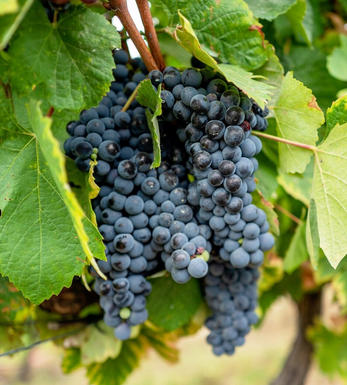
About this WINE

Dow
Dow's Vintage Ports are among the longest-lived, possessing impressive backbone and structure; they are also at the drier end of the scale and often show magical qualities on the nose. Much of the fruit used in declared vintage years comes from the premium vineyards at Quinta do Bomfim, which also makes a very fine wine in non-declared years under that name.
The Symington family has been involved with Dow most of the 20th century, taking full control in 1961 and building on the legacy of the preceding Silva and Dow families. Dow dates back to 1798 when Bruno da Silva, a Portuguese merchant, moved to London and began importing wine from his native country. Through Bruno da Silva, Dow became the first and only Port Company to transport its precious cargo of casks of fine Ports under its own armed protection across the Bay of Biscay during the treacherous Napoleonic wars. Over the next generations there formed a partnership with the Frederick Cosens and they were later joined by George Acheson Warre. Finally in 1877 Silva & Cosens merged with another leading Port company, Dow & Co and it was decided to adopt Dow’s as the brand name.
In 1912 Andrew James Symington was invited to manage the Douro Valley vineyards of Dow and in 1961 the Symington’s finally became sole owners of Dow’s. Five members of the Symington family are currently engaged in the management of Dow’s which is the only surviving independent Port producer in the hands of just one family amongst all the great historic Port companies. Paul, Johnny and Rupert Symington (Andrew Symington’s grandsons) are the joint managing directors and together with Paul’s younger brother Dominic they work towards the development of new markets and customers. Charles Symington is in control of the winemaking. Being one of the most highly regarded winemakers and tasters in the Port industry, with more than 40 vintages to his credit, Peter has passed on his knowledge to son Charles.
The reacquisition of Quinta da Senhora da Ribeira in 1998, after having to be sold in 1954 to ensure the company’s survival at a time when the Port industry was in crisis, will further strengthen Dow's in declared vintage years, as this estate's top-grade fruit will be used in the blend. Along with Quinta da Senhora da Ribeira and Quinta do Bomfim the Symington family privately own Quinta do Santinho and Quinta da Cerdeira which also supply grapes for the production of Dow’s Ports. These four estates together provide Dow’s with one of the largest premium vineyard holdings of any Port firm.
Dow's, with Warre's, lies just beneath the top flight of Vintage Ports and consequently offers less market-driven prices; when one considers the time these wines will keep and improve over, one has to appreciate their sheer value for money.

Port Blend
There are around 40 different grape varieties permitted in the production of Port - however the vast majority of Ports are produced from a blend of 5 grapes - Touriga Nacional, Touriga Francesca, Tinta Barroca, Tinta Roriz, and Tinto Cão.
Touriga Nacional produces small, dark-skinned grapes that produce opaque black wines of great extract and high tannins - it gives grip, body, and structure to the blend.
Touriga Franca has a thinner skin and consequently produces wines lighter in colour and tannins than Touriga Nacional. It contributes fruit, aroma, suppleness and roundness.
Tinta Roriz is the Portuguese name for Tempranillo and its high sugar content and low acidity contribute colour and fruit.
Tinta Barroca which is normally grown at highish altitudes and on north-facing slopes, is prized for producing wines of delicacy, finesse and with smooth, velvety fruit. It brings elegance and sweet, ripe fruit to the final blend.
Finally Tinto Cão produces fine and complex wines, though it is probably the least important of the 5 grapes as its painfully small yields have reduced plantings to almost insignificant levels.



Buying options
Add to wishlist
Description
Crusted Port is a peculiarly British invention, and yet is seldom seen, either here or elsewhere, despite it evocative and theoretically quite accurate name. It is produced at the behest of British Port shippers to provide wines with a similar character to Vintage Port, but in a more accessible style and at a relatively more modest price point.
The wine is a blend of three different and consecutive vintages that have been aged for up to five years in cask, then assembled and aged in bottle for at least a further three years before release. The vintages in question for this, the 2006 bottling are 2000, 2001 and 2003 and all come from A –list Quintas affiliated to the famous House of Dow, itself known for the longevity of its wines and their fantastic stylistic integration between fruit, spirit and tannin.
The nomenclature is appropriate because the wine is bottled without fining or filtration and is therefore, in the manner of bottle aged wines, likely to throw sediment, or, more apposite, to form something resembling a crust.
All this in spite of the fact that it should not be kept quite as long as a vintage port; indeed the wine is theoretically ready for drinking on release; a symphonic rich, sweet and spicy red, but one which will, for up to a decade, develop in complexity and the capacity to afford no small measure of pleasure .Outstanding value, outstanding port.
Simon Field MW, BBR Wine Buyer
.....................................................................................
Wines for our Berrys' own selection are hand-picked by our expert buyers and are standard-bearers of style and quality from classical wine regions, offering exceptional value for money.
wine at a glance
Delivery and quality guarantee